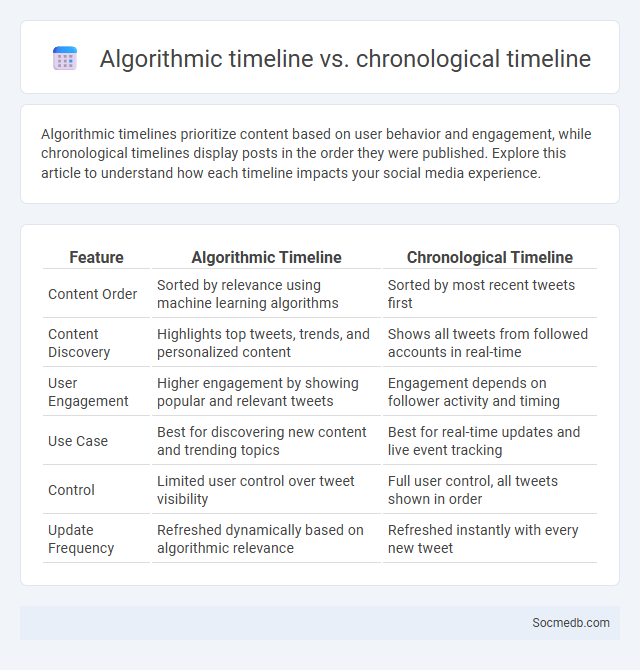
Photo illustration: Algorithmic timeline vs Chronological timeline
Algorithmic timelines prioritize content based on user behavior and engagement, while chronological timelines display posts in the order they were published. Explore this article to understand how each timeline impacts your social media experience.
Table of Comparison
| Feature | Algorithmic Timeline | Chronological Timeline |
|---|---|---|
| Content Order | Sorted by relevance using machine learning algorithms | Sorted by most recent tweets first |
| Content Discovery | Highlights top tweets, trends, and personalized content | Shows all tweets from followed accounts in real-time |
| User Engagement | Higher engagement by showing popular and relevant tweets | Engagement depends on follower activity and timing |
| Use Case | Best for discovering new content and trending topics | Best for real-time updates and live event tracking |
| Control | Limited user control over tweet visibility | Full user control, all tweets shown in order |
| Update Frequency | Refreshed dynamically based on algorithmic relevance | Refreshed instantly with every new tweet |
Introduction to Social Media Timelines
Social media timelines organize posts chronologically, displaying real-time updates from users or brands to enhance engagement and information flow. Platforms like Facebook, Twitter, and Instagram utilize algorithms to prioritize content based on relevance, user interactions, and trending topics. Effective management of social media timelines boosts visibility, fosters community interaction, and drives targeted marketing efforts.
Understanding Algorithmic Timelines
Algorithmic timelines on social media platforms prioritize content based on user behavior, engagement patterns, and content relevance to enhance user experience. These algorithms analyze factors such as likes, comments, shares, and viewing duration to determine which posts appear prominently in a user's feed. Understanding these mechanisms helps content creators optimize posting times and tailor content to increase visibility and audience interaction.
What is a Chronological Timeline?
A chronological timeline on social media displays posts in the exact order they were published, providing users with a real-time, unfiltered view of content. This timeline allows you to see updates from friends, pages, or accounts as they happen, ensuring no important moment is missed due to algorithmic filtering. By prioritizing recency, a chronological timeline enhances your ability to follow conversations and trends as they unfold instantly.
Key Differences Between Algorithmic and Chronological Feeds
Algorithmic feeds prioritize content based on user behavior, engagement, and relevance, displaying posts that the platform predicts will interest You the most. Chronological feeds, however, show posts in the exact order they were published, ensuring You see content as it happens without algorithmic intervention. This fundamental difference affects how quickly trends spread and what content garners visibility on social media platforms.
Advantages of Algorithmic Timelines
Algorithmic timelines on social media platforms enhance Your experience by curating content based on Your interests and interactions, ensuring more relevant posts appear first. This personalized approach increases engagement and saves time by filtering out less pertinent updates. As a result, users find it easier to connect with meaningful content and discover new trends tailored to their preferences.
Benefits of Chronological Timelines
Chronological timelines on social media platforms provide a clear and organized view of posts, allowing you to easily track updates in real-time without missing important content. This linear format enhances user engagement by presenting information in the order it was shared, ensuring that your interactions are timely and relevant. By prioritizing the latest content, chronological timelines help maintain authentic connections and improve the overall social media experience.
User Experience: Algorithmic vs Chronological
Social media platforms employing algorithmic feeds personalize content by analyzing user behavior to boost engagement, delivering posts deemed most relevant rather than in real-time order. Chronological feeds present content strictly by posting time, ensuring users see all posts from followed accounts without algorithmic filtering. Balancing algorithmic relevance and chronological transparency critically impacts user satisfaction, content discovery, and platform interaction dynamics.
Impact on Content Discovery and Engagement
Social media platforms revolutionize content discovery by leveraging algorithm-driven feeds tailored to Your preferences, increasing visibility for niche topics and creators. User engagement surges through interactive features such as likes, shares, and comments, fostering community building and real-time feedback loops. This dynamic environment amplifies content reach and deepens audience connection, making social media essential for content marketing strategies.
Privacy and Transparency Issues
Social media platforms face ongoing challenges with privacy and transparency, as data collection practices often lack clear user consent and exposure to unauthorized access. Algorithms used to curate content and advertisements are frequently opaque, limiting users' understanding of data usage and potential biases. Strengthening regulatory measures and implementing robust encryption can enhance user trust and accountability in social media environments.
Future Trends in Social Media Timeline Algorithms
Future trends in social media timeline algorithms emphasize personalized content delivery driven by advanced machine learning and AI, enhancing user engagement by predicting preferences and behaviors. Platforms are increasingly integrating real-time data analysis to prioritize timely, relevant posts, ensuring your feed remains dynamic and tailored to evolving interests. Enhanced transparency and user control over algorithmic choices are becoming critical, allowing you to customize your social media experience and mitigate filter bubbles.
 socmedb.com
socmedb.com